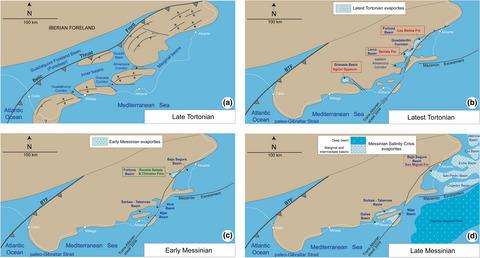当前位置:
X-MOL 学术
›
Basin Res.
›
论文详情
Our official English website, www.x-mol.net, welcomes your
feedback! (Note: you will need to create a separate account there.)
Late Miocene evaporite geochemistry of Lorca and Fortuna basins (Eastern Betics, SE Spain). Evidence of restriction and continentalization
Basin Research ( IF 2.8 ) Pub Date : 2019-10-18 , DOI: 10.1111/bre.12408 Javier García‐Veigas 1 , Luis Gibert 2 , Dioni I. Cendón 3, 4 , David Artiaga 1 , Hugo Corbí 5 , Jesús M. Soria 5 , Tim K. Lowenstein 6 , Enrique Sanz 7
Basin Research ( IF 2.8 ) Pub Date : 2019-10-18 , DOI: 10.1111/bre.12408 Javier García‐Veigas 1 , Luis Gibert 2 , Dioni I. Cendón 3, 4 , David Artiaga 1 , Hugo Corbí 5 , Jesús M. Soria 5 , Tim K. Lowenstein 6 , Enrique Sanz 7
Affiliation

|
[Abstract The Lorca and Fortuna basins are two intramontane Neogene basins located in the eastern Betic Cordillera (SE Spain). During the Late Tortonian—Early Messinian, marine and continental evaporites precipitated in these basins as a consequence of increased marine restriction and isolation. Here we show a stratigraphic correlation between the evaporite records of these basins based on geochemical indicators. We use SO4 isotope compositions and Sr isotopic ratios in gypsum, and halite Br contents to characterize these units and to identify the marine or continental source of the waters feeding the evaporite basins. In addition, we review the available chronological information used to date these evaporites in Lorca (La Serrata Fm), including a thick saline deposit, that we correlate with the First Evaporitic Group in Fortuna (Los Banos Fm). This correlation is also supported by micropalaeontological data, giving a Late Tortonian age for this sequence. The Second Evaporitic Group, (Chicamo Fm), and the Third Evaporitic Group (Rambla Salada Fm) developed only in Fortuna during the Messinian. According to the palaeogeographical scheme presented here, the evaporites of the Lorca and Fortuna basins were formed during the Late Tortonian—Early Messinian, close to the Betic Seaway closure. Sulphate isotope compositions and Sr isotopic ratios of the Ribera Gypsum Mb, at the base of the Rambla Salada Fm (Fortuna basin), match those of the Late Messinian selenite gypsum beds in San Miguel de Salinas, in the near Bajo Segura basin (40 km to the East), and other Messinian Salinity Crisis gypsum deposits in the Mediterranean. According to these geochemical indicators and the uncertainty of the chronology of this unit, the assignment of the Rambla Salada Fm to the MSC cannot be ruled out., Palaeogeographical evolution sketch of the Betic seaway during Late Miocene. ]
中文翻译:

Lorca 和 Fortuna 盆地(Eastern Betics,SE Spain)的晚中新世蒸发岩地球化学。限制和大陆化的证据
[摘要 Lorca 和 Fortuna 盆地是位于贝蒂克山脉东部(西班牙东南部)的两个新近纪山内盆地。在托尔顿晚期—墨西拿早期,由于海洋限制和隔离增加,海相和陆相蒸发岩在这些盆地中沉淀。在这里,我们展示了基于地球化学指标的这些盆地蒸发岩记录之间的地层相关性。我们使用石膏中的 SO4 同位素组成和 Sr 同位素比率以及岩盐 Br 含量来表征这些单元,并确定为蒸发岩盆地提供水源的海洋或大陆来源。此外,我们回顾了用于确定 Lorca (La Serrata Fm) 中这些蒸发岩年代的可用年代信息,包括一个厚盐沉积,我们将其与 Fortuna 的第一蒸发岩群 (Los Banos Fm) 相关联。这种相关性也得到了微古生物学数据的支持,给出了这个序列的晚托顿时代。第二蒸发群 (Chicamo Fm) 和第三蒸发群 (Rambla Salada Fm) 仅在墨西拿时期在福尔图纳发展。根据这里提出的古地理方案,洛尔卡和福尔图纳盆地的蒸发岩形成于托尔托阶晚期至墨西拿早期,靠近贝蒂克海道闭合。Rambla Salada Fm(福尔图纳盆地)底部的 Ribera Gypsum Mb 的硫酸盐同位素组成和 Sr 同位素比与 Bajo Segura 盆地附近(40 公里)的 San Miguel de Salinas 的晚墨西拿亚硒酸盐石膏床相匹配到东部),以及地中海的其他墨西拿盐度危机石膏矿床。根据这些地球化学指标和该单元年代学的不确定性,不能排除将兰布拉萨拉达组归入海间海洋的可能性。晚中新世贝蒂克海道古地理演化简图。]
更新日期:2019-10-18
中文翻译:

Lorca 和 Fortuna 盆地(Eastern Betics,SE Spain)的晚中新世蒸发岩地球化学。限制和大陆化的证据
[摘要 Lorca 和 Fortuna 盆地是位于贝蒂克山脉东部(西班牙东南部)的两个新近纪山内盆地。在托尔顿晚期—墨西拿早期,由于海洋限制和隔离增加,海相和陆相蒸发岩在这些盆地中沉淀。在这里,我们展示了基于地球化学指标的这些盆地蒸发岩记录之间的地层相关性。我们使用石膏中的 SO4 同位素组成和 Sr 同位素比率以及岩盐 Br 含量来表征这些单元,并确定为蒸发岩盆地提供水源的海洋或大陆来源。此外,我们回顾了用于确定 Lorca (La Serrata Fm) 中这些蒸发岩年代的可用年代信息,包括一个厚盐沉积,我们将其与 Fortuna 的第一蒸发岩群 (Los Banos Fm) 相关联。这种相关性也得到了微古生物学数据的支持,给出了这个序列的晚托顿时代。第二蒸发群 (Chicamo Fm) 和第三蒸发群 (Rambla Salada Fm) 仅在墨西拿时期在福尔图纳发展。根据这里提出的古地理方案,洛尔卡和福尔图纳盆地的蒸发岩形成于托尔托阶晚期至墨西拿早期,靠近贝蒂克海道闭合。Rambla Salada Fm(福尔图纳盆地)底部的 Ribera Gypsum Mb 的硫酸盐同位素组成和 Sr 同位素比与 Bajo Segura 盆地附近(40 公里)的 San Miguel de Salinas 的晚墨西拿亚硒酸盐石膏床相匹配到东部),以及地中海的其他墨西拿盐度危机石膏矿床。根据这些地球化学指标和该单元年代学的不确定性,不能排除将兰布拉萨拉达组归入海间海洋的可能性。晚中新世贝蒂克海道古地理演化简图。]











































 京公网安备 11010802027423号
京公网安备 11010802027423号